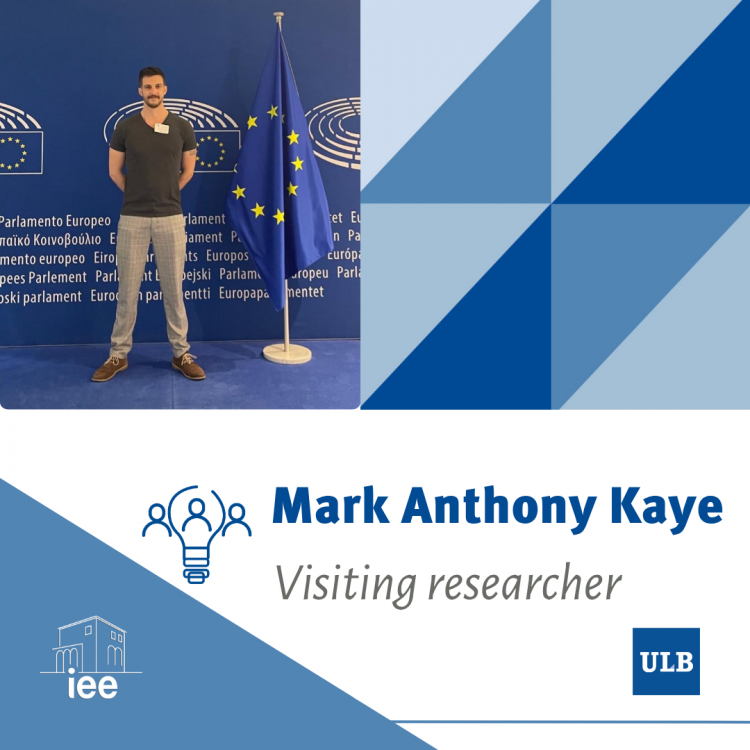 Andreas Dimmelmeier is completing his thesis within the framework of an MSCA-funded GEM-STONES European Joint Doctorate between the University of Warwick (UK) and the Copenhagen Business School (DK). For permission to cite or reproduce any part of this publication, please contact the author
Andreas Dimmelmeier is completing his thesis within the framework of an MSCA-funded GEM-STONES European Joint Doctorate between the University of Warwick (UK) and the Copenhagen Business School (DK). For permission to cite or reproduce any part of this publication, please contact the author
Summary
Sustainable finance is an emerging policy issue. Therefore, the design of “technical instruments” like indicators and definitions that provide the background for policies matters greatly. However, believes about what sustainable finance is and should do as well as interests are reflected in these seemingly technical instruments. Thus, it is important to unpack these instruments, so that the debate can be brought to a political level.
In the following, I link technical instruments to four communities that have been active in the field of sustainable finance over the last 20 years. These communities are bound together by a common framing.
First, there is the historically important, but today marginal community of ethical investors. Second, I describe the actors that emphasise the addition of sustainability issues to the financial risks and opportunities calculus. This frame has dominated the issue throughout the period under analysis. Third, I introduce the climate finance frame, which highlights the need to issue new green financial instruments. Finally, I revisit the critical frame, which advances a systemic criticism of finance.
Introduction
Can and should the financial system address issues like climate change, biodiversity loss or workers’ exploitation? And if the answer to this question is affirmative how should it be done? Should these issues be seen as complimentary targets for financial institutions? Or are they better understood as risks and opportunities that can be integrated into financial decision-making?
These and other related questions have structured “sustainable finance” over the last couple of decades. Financial institutions, regulators, NGOs, International Organisations and other actors have given alternative answers and emphases to these questions. I conceptualise these common answers as frames. One could also speak of common believes or approaches that bind people and organisations together. Frames reduce the uncertainty that actors face when approaching an unfamiliar issue such as sustainable finance. Frames also help them to define their interests.
I argue that frames influence the governance of sustainable finance. There are two mechanisms that serve this end. First, there is a process of political debating that occurs in the context of formal decision making. Here, everybody involved agrees that something should be done about sustainable finance at the level of the polity. For example, a national strategy should be created, or an EU regulation should be passed.
The involved actors disagree, however, over topics, where their frames are related to opposing positions. A classic example is the discussion about whether investors should divest from unsustainable companies or whether they should use their engagement and voting rights, instead. The way in which these debates play out is not fundamentally distinct from other areas of policy making. The different actors advance their position, try to garner support among policymakers, (peer) interest groups, the (specialised) media and the interested population. There is, however, a second mechanism that arguably matters a great deal more.
Even if you have followed the conversation on sustainable finance, you might be excused if terms like “green taxonomy”, “transition and physical risks” or “forward-looking scenarios” mean little to you. Within the expert community these words refer, however, to some of the most impactful issues. The parameters that are set through these instruments will to a large extent determine whether the financial system can go on with business as usual or whether significant changes are forthcoming.
The point here is that the relatively recent nature of sustainable finance means that the categories that are needed to govern it are still in the making. However, these seemingly technical categories are political and have distributional outcomes.
Unpacking the content of technical instruments and linking them to the actors that advance a particular understanding can, thus, help us to identify which perspectives are overrepresented and which parts of the debate are missing.
Most importantly perhaps, making explicit the ideas and arguments on which a technical instrument is based can help to see more clearly how it aims to make finance sustainable. Translating technical language to policymakers and the interested public enables us to bring the discussion back to a more politicised level.
Key findings
The analysis underlying this policy brief used network analysis, qualitative and quantitative content analysis, elite interviews and participant observation data to establish the presence and importance of different frames in sustainable finance between 1998 and 2018. Combining these methods allows both for a detection of actor coalitions as well as for analysing the content of the frames.
In the 1980s and 1990s sustainable finance was dominated by small, often religiously motivated (i.e. evangelical Christian) investors, who postulated that the ethics of beneficiaries should be reflected in investment allocations. This became known as Socially Responsible Investment or SRI. In practice, SRI was operationalised by collecting information about the ethical dimensions of companies and subsequently excluding the ‘bad’ ones (think weapons, but also contraception for the Christian investors) or over-representing the ‘good’ ones.
The focus on often-idiosyncratic values meant, however, that SR investors did not have a coherent position regarding either policy debates or technical instruments. Instead, already by the late 1990s a framing that emphasised that incorporating Environmental, Social and Governance (ESG) issues could lead to a better management of financial risks and opportunities occupied the centre of attention. The preoccupation of the adherents to this frame was to determine those ESG issues that could enhance risk adjusted returns. In this context, the emphasis rests on “financially material” sustainability data.
In the beginning, the actors within the risks and opportunities frame adopted a broad definition of sustainability-related risks. Reputational risks from the mass layoffs of workers were considered alongside risks from biodiversity loss, climate change and water-related issues. In the subsequent years, breadth was, however, increasingly traded for depth. This meant that the focus narrowed down to climate-related risks. In other words, while the technicality of e.g. indicators, thresholds and models is crucial for governing an issue like sustainable finance, linking them to frames enables policy makers to call out attempts that black-box ideas that would have garnered little support otherwise.
Climate-related risks (and opportunities) are routinely separated into transition risks and physical risks. The former category is about financial losses that accrue from policy-responses to climate change (e.g. carbon taxes making shares in a coal company worthless). Physical risks, on the other hand, materialise when the physical assets that underlie a financial instrument are affected by changes in the natural world that can be linked to climate change (e.g. flooded coastal real estate or disruption of a supply chain due to a heatwave).
Importantly, over the last years, forward-looking metrics and scenario analysis have become more important. Scenarios often use transition scenario (e.g. the 2 degrees scenario from the IPCC) to map the physical or transition risks for a company, a financial institution or an entire financial system.
The Financial Stability Board’s Task Force on Climate Related Disclosures (FSB TCFD) has, for instance, recommended that companies and financial institutions submit scenario analyses. Furthermore, several central banks (e.g. the Bank of England, De Nederlandse Bank) are currently working on forward-looking climate stress tests.
One important aspect of the risks and opportunities logic is that extra-financial judgements like normative convictions or political goals are absent. Instead, sustainability issues are integrated with other, more traditional financial risks. This implies that the different risk factors can be compared in decision-making.
For instance, an investment with marginally greater climate-related risk might be preferred if it has significantly less currency risk than its alternative. Moreover, investors with high exposure to climate-related risks might opt for a hedge rather than for a reduction in their position. Notably, this possibility disappears if climate-related risks are conceptualised as systemic.
The different variations of the risks and opportunities framing dominated sustainable finance over the last 20 years. From the late 2000s onward, there is, however, a complementary framing. This frame focusses less on screening existing financial assets but on promoting new financial instruments that address sustainability issues (e.g. green bonds).
The promotors of this frame often come from the development community, which includes public development banks like the European Investment Bank. The reasoning of this frame is that to address the enormous challenge of climate change vast amounts of funding will be required. The public sector alone does, however, not dispose of these funds. Therefore, new financial instruments that mobilise private climate finance are needed.
To operationalise this, two components are needed. First, we need to know which activities contribute to the mitigation of and adaptation to climate change (and other sustainability issues). This is done by instruments like the “green taxonomy” that is currently developed by the EU and provides indicators and thresholds.
Second, the financial plumbing between the trillions of dollars, euros, yens etc. that sit on the balance sheets of pension funds, insurance companies and sovereign wealth funds and the green projects needs to be addressed. Apart from green bonds, risk-sharing mechanism in which public funding provides concessionary seed funding or takes on the riskier tranches of securitised instruments have been proposed. This need for public funds to settle for less returns arises from the need to leverage funds and sometimes also from the regulations of pension funds, which are forbidden from taking risky positions. Critics have, however, pointed out that this might lead to a socialisation of losses and to a privatisation of gains.
This brings us to the last frame: This critical frame advances a systemic criticism of the contemporary financial system. Accordingly, only a major reorganisation of finance can address the environmental and social challenges. This is because finance is part of the problem and not of the solution. The adherents to critical frame point out the negative impact of current investments and call out financial institutions that in spite of their public commitments continue to finance activities like coal mining. One class of technical instruments of the critical frame are system performance metrics. These high-level measures map the performance of the financial system for providing funding for sustainable activities as well as its efficiency (e.g. cost of intermediation).
Policy recommendations
- Find the sweet spot between technocracy and public involvement: Technical instruments are necessary for the governance of sustainable finance. Apart from black-boxing ideas and interests, the lack of political debates might also decrease the legitimacy of policies.
- Avoid the pitfalls of “data in search for theory”: The narrowing down of sustainable finance to climate change and the energy transition can partly be explained by the fact that those issues are well understood. However, less data-rich issues like biodiversity have considerable ramifications as well.
This research has received funding from the European Union’s Horizon 2020 Research and Innovation programme under the Marie Sklodowska-Curie Grant Agreement No 722826
To learn more about the European Joint Doctorate “Globalisation, Europe & Multilateralism – Sophistication of the Transnational Order, Networks, and European Strategies” (GEM-STONES), visit www.gem-stones.eu
Suggested Reading
Adelphi, COWI Denmark and Eunomia (2017). Defining “Green” in the Context of Green Finance. Report for DG CLIMA
Crifo, P., Durand, R., & Gond, J.-P. (2019). Encouraging Investors to Enable Corporate Sustainability Transitions: The Case of Responsible Investment in France. Organization & Environment, 32(2), 125–144.
European Investment Bank / People’s Bank of China (2017). The need for a common language in Green Finance: Towards a standard neutral taxonomy for the environmental use of proceeds
Newell, P., & Paterson, M. (2010). Climate capitalism: Global warming and the transformation of the global economy. Cambridge; New York: Cambridge University Press.
UNEP Inquiry (2018). Making Waves: Aligning the Financial System with Sustainable Development.
- AGORA© FORUM POLICY BRIEF
- GEM-STONES AGORA© FORUM, MARCH 2020
- © Photo: Piqsels




